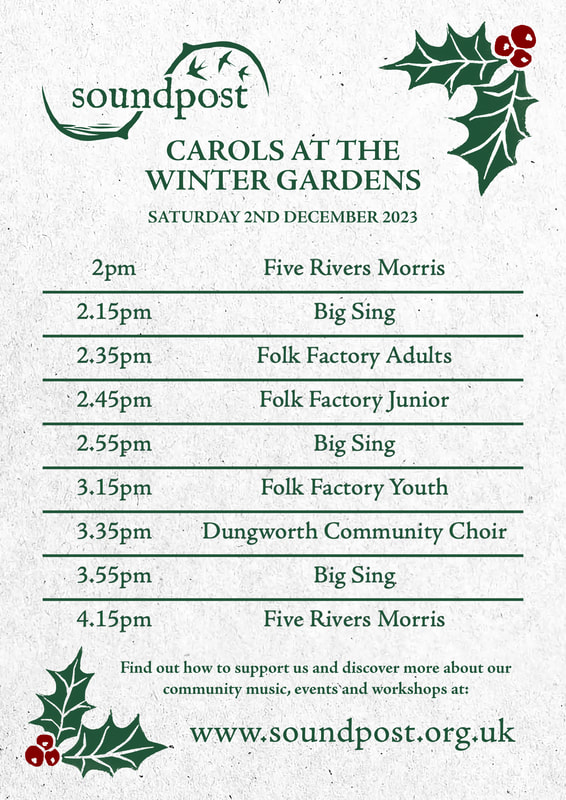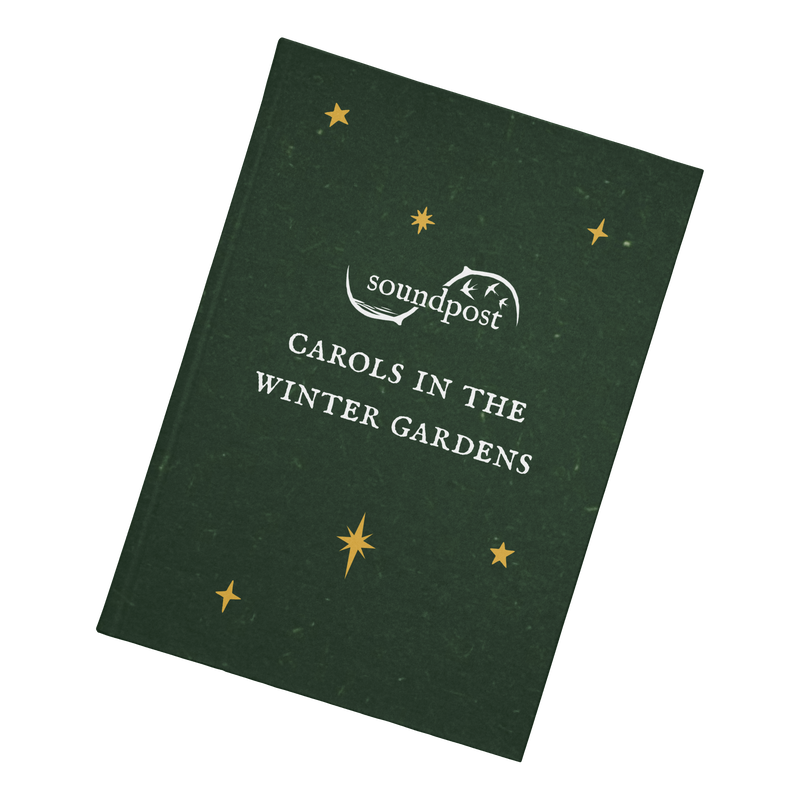Carols at the Winter Gardens
|
|
Here in Sheffield, we have a very special tradition at Christmas time, as we gather together to sing our own regional versions of festive songs, passed down through the years. Known as the Sheffield Carols, this is a tradition close to our hearts here at Soundpost, and each year we love to get out in the community to share songs with you all.
The carols are part of our region's history, and we want them to continue to be sung, enjoyed and passed down for many more years to come. To help make this happen, we've published a free guide which can be downloaded right here, so that everyone can be part of this living tradition. |
An introduction
By Ian Russell
There is no doubt that the singing of these carols represents one of the finest traditions found in England today and the city can be justly proud of this rich musical heritage.
What is even more remarkable is that the tradition predates the well-known popular repertoire, which was largely introduced and constructed by the Victorian high church men. These ‘village carols’ are from the grassroots and have been sung and treasured over more than two and a half centuries by communities in places such as Lodge Moor, Stannington, Dungworth, Loxley, Bradfield, Wadsley, Wharncliffe Side, Worrall, Oughtibridge, Grenoside, Ecclesfield and other locations to the north and west of the city centre.
The carols are not lullabies of the ‘gentle Jesus, meek and mild’ kind that we hear played incessantly over the airwaves and in the shopping malls, but full-bodied, exuberant songs of celebration, sung in parts, which feel more at home in the village pub than the choir stall. There is even an air of competition between the two main parts, especially in the fuguing sections in which the trebles and basses make separate entries at different times and overlap.
Many of the tunes were composed by village craftsmen or artisans, such as John Hall of Sheffield Park, a blacksmith who ‘worked at the anvil and died in the poorhouse in 1794’. To him, we attribute ‘Hark, Hark! What News’, known as ‘Good News’, which is the most widely sung carol in the local repertoire. William Womack from near Stannington, who farmed and worked in the metal trades, wrote the tune ‘Back Lane’ in the early 1800s.
In essence, the tradition is dynamic and eclectic, and certainly not exclusive or fossilised. Among the repertoire, you will find examples of glees, anthems, revivalist hymns, hunting songs, parlour ballads, customary songs, and carols from near and far; the main criterion for their selection being that they are accepted and enjoyed as part of Christmas festivities.
In the tradition, the singing of these carols is refreshingly spontaneous, informal and vigorous. It does not depend on a caroller having a ‘beautiful’ singing voice or an ability to read a printed music score but rather on oral tradition – learning the carols by ear. There are no formal memberships or appointed conductors, and participants decide for themselves which part they would like to sing, regardless of gender conventions, often changing from the melody line mid-carol to another part, as they gain confidence. I hope you will feel the urge to join in and sing the carols with us, as countless others have over the generations. You will be in excellent company!
By Ian Russell
There is no doubt that the singing of these carols represents one of the finest traditions found in England today and the city can be justly proud of this rich musical heritage.
What is even more remarkable is that the tradition predates the well-known popular repertoire, which was largely introduced and constructed by the Victorian high church men. These ‘village carols’ are from the grassroots and have been sung and treasured over more than two and a half centuries by communities in places such as Lodge Moor, Stannington, Dungworth, Loxley, Bradfield, Wadsley, Wharncliffe Side, Worrall, Oughtibridge, Grenoside, Ecclesfield and other locations to the north and west of the city centre.
The carols are not lullabies of the ‘gentle Jesus, meek and mild’ kind that we hear played incessantly over the airwaves and in the shopping malls, but full-bodied, exuberant songs of celebration, sung in parts, which feel more at home in the village pub than the choir stall. There is even an air of competition between the two main parts, especially in the fuguing sections in which the trebles and basses make separate entries at different times and overlap.
Many of the tunes were composed by village craftsmen or artisans, such as John Hall of Sheffield Park, a blacksmith who ‘worked at the anvil and died in the poorhouse in 1794’. To him, we attribute ‘Hark, Hark! What News’, known as ‘Good News’, which is the most widely sung carol in the local repertoire. William Womack from near Stannington, who farmed and worked in the metal trades, wrote the tune ‘Back Lane’ in the early 1800s.
In essence, the tradition is dynamic and eclectic, and certainly not exclusive or fossilised. Among the repertoire, you will find examples of glees, anthems, revivalist hymns, hunting songs, parlour ballads, customary songs, and carols from near and far; the main criterion for their selection being that they are accepted and enjoyed as part of Christmas festivities.
In the tradition, the singing of these carols is refreshingly spontaneous, informal and vigorous. It does not depend on a caroller having a ‘beautiful’ singing voice or an ability to read a printed music score but rather on oral tradition – learning the carols by ear. There are no formal memberships or appointed conductors, and participants decide for themselves which part they would like to sing, regardless of gender conventions, often changing from the melody line mid-carol to another part, as they gain confidence. I hope you will feel the urge to join in and sing the carols with us, as countless others have over the generations. You will be in excellent company!
An introduction to the carols
To help open up the carols for everyone, we've created a handy booklet with all the lyrics and information you need. Click below to download your copy!
Our work with schools
To ensure that the carols continue to be passed on through the years, it's vital to teach the songs to the next generation. Recently, we teamed up with three local schools (Loxley Primary, Oughtibridge Primary and Wharncliffe Side Primary) to teach them some of the carols. Below, you can hear recordings of some of the finished songs!
Find out more
Want to know more about carols and how you can get involved? Get in touch!
Want to know more about carols and how you can get involved? Get in touch!


